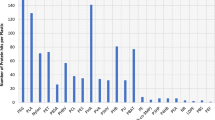Abstract
A microbial enrichment culture from brackish sediments was able to grow on octadec-1-ene (an unsaturated aliphatic hydrocarbon) as sole source of carbon and energy, under methanogenic conditions. Octadecene degradation is stopped either when bromoethanesulfonic acid, a selective inhibitor of methanogenesis is introduced, or when hydrogen is introduced. In the presence of bromoethanesulfonic acid, the degradation is restored by the addition of a hydrogenotrophic sulfate-reducing microorganism with sulfate. Results of molecular biodiversity, which revealed the presence of bacteria as well as of acetoclastic and hydrogenotrophic methanogens, are consistent with a syntrophic degradation involving Bacteria and Archaea. This is the first demonstration of syntrophic alkene degradation by microbial communities, showing that syntrophy is more widespread than we could have thought so far. These results highlight the need for a better understanding of microbial interactions and their role in the organic-matter degradation in polluted environments.



Similar content being viewed by others
References
Aeckersberg F, Back F, Widdel F (1991) Anaerobic oxidation of saturated hydrocarbons to CO2 by a new type of sulfate-reducing bacterium. Arch Microbiol 156:5–14
Bianchi G (1995) Plant waxes. In: Hamilton RJ (ed) Waxes: chemistry, molecular biology and functions. The Oily Press, Dundee, pp 175–222
Bonin P, Cravo-Laureau C, Michotey V, Hirschler-Réa A (2004) The anaerobic hydrocarbon biodegrading bacteria: an overview. Ophelia 58:243–254
Bradford MM (1976) A rapid and sensitive method for the quantitation of microgram quantities of protein utilizing the principle of protein-dye binding. Anal Biochem 72:248–254
Chang W, Um Y, Holoman TRP (2006) Polycyclic aromatic hydrocarbon (PAH) degradation coupled to methanogenesis. Biotechnol Lett 28:425–430
Cline JD (1969) Spectrophotometric determination of hydrogen sulfide in natural waters. Limnol Oceanogr 14:454–458
Curiale JA, Frolov EB (1998) Occurrence and origin of olefins in crude oils. A critical review. Org Geochem 29:397–408
Elshahed MS, McInerney MJ (2001) Is interspecies hydrogen transfer needed for toluene degradation under sulfate-reducing conditions? FEMS Microbiol Ecol 35:163–169
Ficker M, Krastel K, Orlicky S, Edwards E (1999) Molecular characterization of a toluene-degrading methanogenic consortium. Appl Environ Microbiol 65:5576–5585
Gray ND, Sherry A, Grant RJ, Rowan AK, Hubert CRJ, Callbeck CM, Aitken CM, Jones DM, Adams JJ, Larter SR, Head IM (2011) The quantitative significance of Syntrophaceae and syntrophic partnerships in methanogenic degradation of crude oil alkanes. Environ Microbiol 13:2957–2975
Grossi V, Cravo-Laureau C, Guyoneaud R, Ranchou-Peyruse A, Hirschler-Réa A (2008) Metabolism of n-alkanes and n-alkenes by anaerobic bacteria: a summary. Org Geochem 39:1197–1203
Grossi V, Cravo-Laureau C, Rontani J-F, Cros M, Hirschler-Réa A (2011) Anaerobic oxidation of n-alkenes by sulfate-reducing bacteria from the genus Desulfatiferula: n-ketones as potential metabolites. Res Microbiol 162:915–922
Hatamoto M, Imachi H, Yashiro Y, Ohashi A, Harada H (2007) Diversity of anaerobic microorganisms involved in long-chain fatty acid degradation in methanogenic sludges as revealed by RNA-based stable isotope probing. Appl Environ Microbiol 73:4119–4127
Jones DM, Head IM, Gray ND, Adams JJ, Rowan AK, Aitken CM, Bennett B, Huang H, Brown A, Bowler BFJ, Oldenburg T, Erdmann M, Larter SR (2008) Crude-oil biodegradation via methanogenesis in subsurface petroleum reservoirs. Nature 451:176–180
Jukes TH, Cantor CR (1969) Evolution of protein molecules. In: Munro IN (ed) Mammalian protein metabolism. Academic Press, New York, pp 211–232
Martens CS, Berner RA (1974) Methane production in the interstitial waters of sulfate-depleted marine sediments. Science 185:1167–1169
Mbadinga SM, Li K-P, Zhou L, Wang L-Y, Yang S-Z, Liu J-F, Gu J-D, Mu B-Z (2012) Analysis of alkane-dependent methanogenic community derived from production water of a high-temperature petroleum reservoir. Appl Microbiol Biotechnol. doi:10.1007/s00253-011-3828-8
Meckenstock RU (1999) Fermentative toluene degradation in anaerobic defined syntrophic coculture. FEMS Microbiol Lett 177:67–73
Oremland RS, Capone DG (1988) Use of specific inhibitors in biogeochimistry and microbial ecology. In: Marshall KC (ed) Advances in microbial ecology, vol 10. Plenum Press, New York, pp 285–383
Oremland RS, Polcin S (1982) Methanogenesis and sulfate reduction: competitive and noncompetitive substrates in estuarine sediments. Appl Environ Microbiol 44:1270–1276
Pfennig N, Trüper HG (1992) The family Chromatiaceae. In: Balows A, Trüper HG, Dworkin M, Harder W, Schleifer KH (eds) The prokaryotes. Springer, New York, pp 3200–3221
Pfennig N, Widdel F, Trüper HG (1981) The dissimilatory sulfate-reducing bacteria. In: Starr MP, Stolp H, Trüper HG, Balows A, Schlegel HG (eds) The prokaryotes. Springer, Berlin, pp 926–940
Schink B (1985) Degradation of unsaturated hydrocarbons by methanogenic enrichment cultures. FEMS Microbiol Ecol 31:69–77
Siddique T, Penner T, Semple K, Foght JM (2011) Anaerobic biodegradation of longer-chain n-alkanes coupled to methane production in oil sands tailings. Environ Sci Technol 45:5892–5899
Sousa DZ, Smidt H, Alves MM, Stams AJM (2009) Ecophysiology of syntrophic communities that degrade saturated and unsaturated long-chain fatty acids. FEMS Microbiol Ecol 68:257–272
Thomsen TR, Finster K, Ramsing NB (2001) Biogeochemical and molecular signatures of anaerobic methane oxidation in a marine sediment. Appl Environ Microbiol 67:1646–1656
Volkman JK, Barrett SM, Blackburn SI, Mansour MP, Sikes EL, Gelin F (1998) Microalgal biomarkers: a review of recent research developments. Org Geochem 29:1163–1179
Widdel F, Bak F (1992) Gram-negative mesophilic sulfate-reducing bacteria. In: Balows A, Trüper HG, Dworkin M, Harder W, Schleifer KH (eds) The prokaryotes. Springer, New York, pp 3353–3378
Widdel F, Knittel K, Galushko A (2010) Anaerobic hydrocarbon-degrading microorganisms: an overview. In: Timmis KN (ed) Handbook of hydrocarbon and lipid microbiology. Springer, Berlin, pp 1998–2021
Zengler K, Richnow HH, Rossello-Mora R, Michaelis W, Widdel F (1999) Methane formation from long-chain alkanes by anaerobic microorganisms. Nature 401:266–269
Acknowledgments
The authors thank Virgile Calvert, Michaël Pigache, and Zied Medfai for their technical help.
Author information
Authors and Affiliations
Corresponding author
Rights and permissions
About this article
Cite this article
Hirschler-Réa, A., Cravo-Laureau, C., Casalot, L. et al. Methanogenic Octadecene Degradation by Syntrophic Enrichment Culture from Brackish Sediments. Curr Microbiol 65, 561–567 (2012). https://doi.org/10.1007/s00284-012-0195-3
Received:
Accepted:
Published:
Issue Date:
DOI: https://doi.org/10.1007/s00284-012-0195-3




